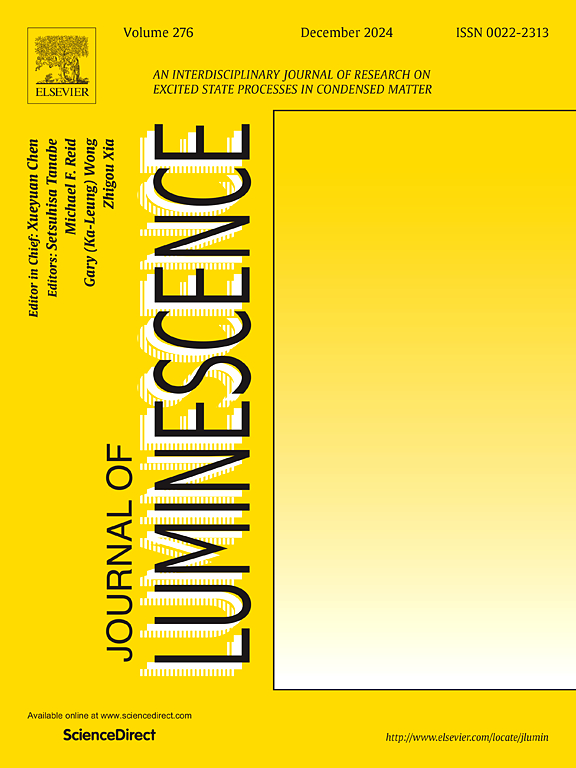Studying the photo-, thermo-luminescence properties and energy transfer processes in K2Y1-xEuxF5 single crystals
IF 3.3
3区 物理与天体物理
Q2 OPTICS
引用次数: 0
Abstract
The single-phase orthorhombic K2Y1-xEuxF5 (x = 0.01, 0.1, 0.3, 0.5 and 1.0) single crystals have been synthesized using the hydrothermal method. The spectral and ligand field properties of the crystals were analyzed within the framework of the Judd-Ofelt theory using two methods based on luminescence and luminescence excitation spectra, the latter showing higher reliability of calculated intensity parameters. The behavior of the Ω2 and Ω6 parameters with the rise of the Eu3+ concentration indicates an increase in asymmetry and rigidity of the medium in the vicinity of Eu3+ ions. The concentration quenching of Eu3+ - 5D0 luminescence was proposed to relate to the energy transfer from Eu3+ ions to defects. The thermoluminescence (TL) glow curve (with heating rate of 5 oC/s) of the K2Y0.9Eu0.1F5 sample after being exposed to beta radiation indicates two TL peaks at around 205 and 327 °C corresponding to the electron traps with a depth of 1.32 and 2.07 eV, respectively. The obtained results show the applicability of synthesized K2Y1-xEuxF5 crystals in laser technique and in TL dosimetry for radiation field discrimination.
研究了K2Y1-xEuxF5单晶的光、热发光性质和能量传递过程
采用水热法合成了单相正交K2Y1-xEuxF5 (x = 0.01, 0.1, 0.3, 0.5和1.0)单晶。在Judd-Ofelt理论的框架下,采用基于发光光谱和发光激发光谱的两种方法对晶体的光谱和配体场特性进行了分析,后者显示出计算强度参数的更高可靠性。随着Eu3+浓度的增加,Ω2和Ω6参数的行为表明Eu3+离子附近介质的不对称性和刚性增加。提出了Eu3+ - 5D0发光的浓度猝灭与Eu3+离子向缺陷的能量转移有关。辐照后K2Y0.9Eu0.1F5样品的热释光(TL)发光曲线(升温速率为5 oC/s)显示,在205°C和327°C附近有两个TL峰,分别对应深度为1.32和2.07 eV的电子阱。结果表明,合成的K2Y1-xEuxF5晶体在激光技术和TL剂量学辐射场判别中具有适用性。
本文章由计算机程序翻译,如有差异,请以英文原文为准。
求助全文
约1分钟内获得全文
求助全文
来源期刊

Journal of Luminescence
物理-光学
CiteScore
6.70
自引率
13.90%
发文量
850
审稿时长
3.8 months
期刊介绍:
The purpose of the Journal of Luminescence is to provide a means of communication between scientists in different disciplines who share a common interest in the electronic excited states of molecular, ionic and covalent systems, whether crystalline, amorphous, or liquid.
We invite original papers and reviews on such subjects as: exciton and polariton dynamics, dynamics of localized excited states, energy and charge transport in ordered and disordered systems, radiative and non-radiative recombination, relaxation processes, vibronic interactions in electronic excited states, photochemistry in condensed systems, excited state resonance, double resonance, spin dynamics, selective excitation spectroscopy, hole burning, coherent processes in excited states, (e.g. coherent optical transients, photon echoes, transient gratings), multiphoton processes, optical bistability, photochromism, and new techniques for the study of excited states. This list is not intended to be exhaustive. Papers in the traditional areas of optical spectroscopy (absorption, MCD, luminescence, Raman scattering) are welcome. Papers on applications (phosphors, scintillators, electro- and cathodo-luminescence, radiography, bioimaging, solar energy, energy conversion, etc.) are also welcome if they present results of scientific, rather than only technological interest. However, papers containing purely theoretical results, not related to phenomena in the excited states, as well as papers using luminescence spectroscopy to perform routine analytical chemistry or biochemistry procedures, are outside the scope of the journal. Some exceptions will be possible at the discretion of the editors.
 求助内容:
求助内容: 应助结果提醒方式:
应助结果提醒方式:


